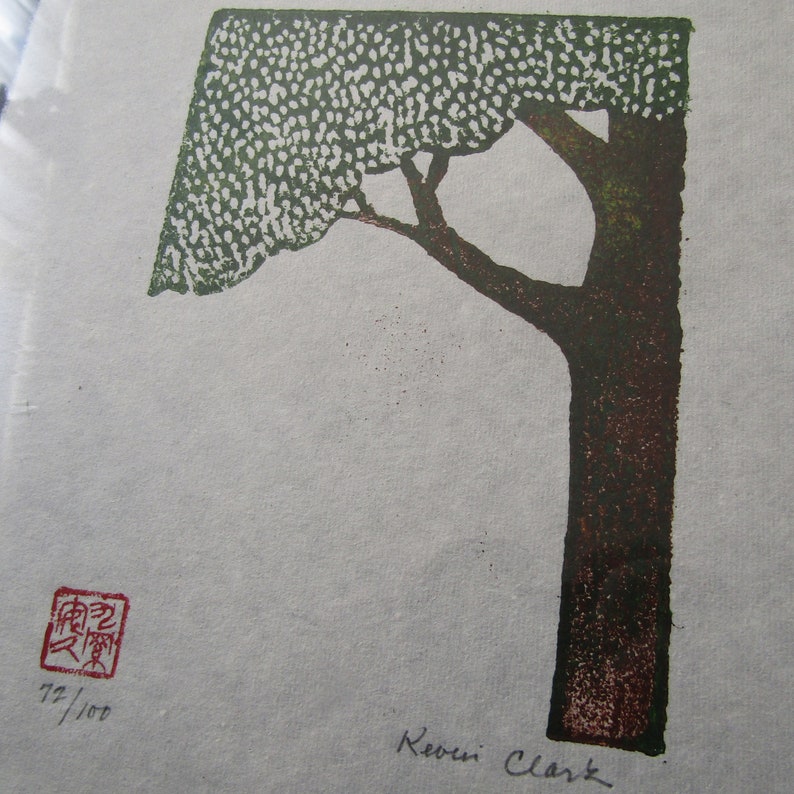

This woodblock was cut from cherry wood or pear wood but because of black ink buildup, it is difficult to discern other than from the back. As you can imagine this is a very rare woodblock for it was difficult to find wood of sufficient size to make blocks of even modest dimensions.

Being offered is this original woodcut printing plate of Daruma, originally from the Myouryuji Temple in Kanazawa, as well as the woodblock print made from the block, and represented a time when inner peace was of importance. The first prints were just black-and-white prints ( sumizuri-e) and before the “kento”, were invented in the 18th century for multi-colored woodblocks referred to as brocade images (nishiki-e). During the period that this wood plate was used, woodblock printmaking was done only in Buddhist monasteries, for the purpose of reproducing Buddhist texts and images, later also for books in which thousands of images were printed in Japan from the period about 1710-1875. The Japanese technique of woodblock printmaking is very different from the Western technique in that water-based ink is applied with a brush and, while being printed by hand, is pressed deeply into the absorbent Japanese paper. Artisan | Interactive Toymaker: Hiroi, Masaaki.Sosaku Kokeshi: A New Look at an Old Tradition.Blog | Celebration of Mingei - Journey Through Japan.- Artisan | Interactive Toymaker: Tsuta Family.- Artisan | Interactive Toymaker: Hiroi, Masaaki.Not only that, but they also got a chance to see me work and for me to prove my skills to them, something I was feeling self-conscious about until then. It was also really nice to spend the weekend with 13 of the other printmakers at the Peregrine Press, allowing them to get to know me and me to get to know me in a more casual atmosphere for the first time. I have always enjoyed the process of creating woodblock and lino prints, and these registrations and printing systems learned in April Vollmer’s workshop expanded what I can do with those.
Ink out of grooves moku hanga registration#
I was really impressed by the ease and accuracy during printing using the kento registration system.

These allow for the paper to slide right into the correct position. With this process, a groove the depth of the paper is carved directly into the margins of the block at the bottom and the bottom right corner. The other big characteristic of moku hanga is the distinct registration system, called the kento registration. The latter is very important to many printmakers, and particularly many in the Peregrine Press, who are concerned about the safety of many printmaking products. This processes allows a lot of control over the color and transparency, is printed very quickly, and is non-toxic. Contemporary printing is also traditionally done with a press, while moku hanga is printed by hand.

With moku hanga, printing is done with water based pigments mixed with rice paste and applied with a brush. April explained that this developed to be compatible with the letterpress, which needed oil based ink on metal letters. Contemporary printing uses oil-based inks similar to etchings, or water based inks manufactured to have similar properties as the oil based. Areas that the artist cuts away carry no ink, while characters or images at surface level carry the ink to produce the print. The main difference between Japanese woodblock printing and contemporary western printing is the use of water based ink. In her practices and teaching, she honors and respects the traditional printing techniques while applying them to contemporary art making. A movement that became popular during post WWII. Sosaku-hanga: 'self-prints'- prints that are designed, carved, and printed by the artist. Shina: Japanese basswood or lindenwood often used as easily-carved woodblocks. This technique is most commonly recognized in the ukiyo-e prints, “pictures of the floating world. Shin-hanga: 'new prints'- refers 20th century woodblock printmaking revival often featuring layered color landscapes. She works in woodblock printing, specifically the traditional Japanese technique of moku hanga printing. This past weekend the Peregrine Press hosted a workshop with artist April Vollmer.


 0 kommentar(er)
0 kommentar(er)
